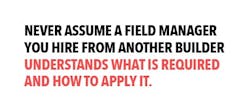My colleagues and I have witnessed an interesting trend during the past year, typified by a call that goes like this, “We are custom builders. We build 15 to 20 units a year and could maybe grow to 25, 30 at the most. We aren’t keeping pace with the demands of starting over from scratch with every single house. The constant changes are killing us, and our margins are falling short.”
A similar call comes from a small builder that already began the transition. They build production units but are stuck at a level, usually no more than 40 or 50 units, often less, and can’t seem to grow effectively. Both types of builders do just about anything a customer asks to sell a home, even the one that now considers himself a production builder. Both acknowledge difficulties recruiting and keeping good trade labor. They’re frustrated and hope someone has a proven formula to make the transition from custom to production—or something that looks a lot more like the latter. Hence the call to TrueNorth.
What Does It Mean to Be a Production Builder?
“So you want to become a production builder?” we ask, and typically their reply is a somewhat hesitant “Yes.” They don’t want to become a “tract builder,” a term that carries a lot of baggage in their eyes, going all the way back to the post-WWII days of Levittown. They still want to build great homes and want customers to love their homes, even love their builder.
In the past, this has been achieved by offering buyers just about anything they want. Yet, for many of these builders, it’s wearing them out. I know something of what they feel. One of my sisters is a custom builder in a southern state. Her houses are designed by expensive architects for high-income families and run in the $2 million to $5 million range. The buyers want what they want, when they want it, even if it means tearing off one very expensive roof and restarting with another found while on vacation in Italy, or paying $65K to move a 440 amp electrical panel to a new place where you can’t see it, from the original place where, well, uhhhh, you couldn’t see it either. Schedules grow from a leisurely 12 months to a ridiculous 18 months for no other reason than personal whims. I feel my sister’s pain and I flat out couldn’t do what she does. Not all of her clients are nuts … just two-thirds of them.
Thus, it’s no surprise that custom builders, whether they build multimillion dollar homes or $500K units, find the idea of bringing production elements to their business appealing. We engage them in a conversation about what production building means to them. They usually focus first on the notion of having a collection of “portfolio homes.” This typically consists of eight to 10 homes with set floor plans and an elevation or two each. The goal is to get those plans fully costed out, learn how to build them well, and sell those plans as much as possible, typically with a liberal policy of “personalization,” including structural changes. But they’ll still do full custom when a client walks in the door with their own plan.
When Shifting From Custom to Production Building, Can You Serve Two Masters?
That’s a pretty good place to start. In moving from custom to production building, there are a whole lot of things to consider, and builders are often surprised at just how different custom and production building are. This is confirmed by the fact most builders I have known that try to do both production and custom find it extremely difficult. They do one much better than the other, or they experience marginal performance in both.
As the venerable Luke the Evangelist wrote nearly 2,000 years ago: “No one can serve two masters. Either you will hate the one and love the other, or you will be devoted to the one and despise the other.” We all know this from our personal lives, and it is felt in everything from jobs to avocations to relationships. I’ve been there. It’s possible to serve multiple masters for a while—and many readers are doing that right now—but often at great personal and professional cost. Don’t straddle the fence. Decide which builder you really want to be.
In just the past month I received calls from the two types of builders described above, each wanting a proposal on how we could help them make the transition to production. I’ve always avoided consulting proposals that say, in so many words, “Send us money and we’ll come and be smart for you!” I find clients are far happier buying a defined process that specifically outlines what we will do, the deliverables they should expect, and at what cost. Thus, after these two most recent requests, I launched into my development mode, which means I let the idea bang around in my head for a few weeks, making lots of random notes.
There were some promising ideas and some dead-ends. Finally, I went to the whiteboard to outline a “custom-to-production conversion process” model—what it takes to think and build like a production home builder. What we’re talking about is a different way of operating—adopting a production operating philosophy. It requires a different way of thinking, each day.
The following is my first pass at what you need to know and specific things to do. I expect it will evolve over time, but it feels right insofar as it lays out the key points of conversion. At a minimum, it’s a good place to start.
7 Factors Custom Builders Should Consider When Shifting to Production Building
1) Change in strategy
This is far more difficult than most imagine. How do you change the way you and your people think, talk, and act when you’ve been doing it the same way for 10, 20, or 30 years? Maybe your dad did it 30 years before you? You’ve been a builder who loves to say, “Sure, we can do that. We can build anything.” Such thinking, plus the talk that goes with it, internally with your staff and externally with customers, suppliers, and trades, has driven your approach to home building.
Now it’s time to shift the thought process for the entire company to, “How do we sell what we know how to build well and profitably?” Or, better said: How do we guide our customers to willingly buy “portfolio plans,” without feeling compromised?
You have some big decisions to make. How far will you go with personalization for the customer? Will you make structural changes? How will you handle options and selections? Will you establish genuine cutoff dates for options and selections and manage the customer to them, as true production building requires? Then, the two toughest questions of all: First, are you willing to walk away from a sale where the customer demands too much customization of a portfolio plan? We call this, “pucker factor.” Second, will you build spec inventory to smooth out production and/or have homes ready for buyers who are ready today? This question affects all six additional elements below.
2) Change in product and design philosophy
In the custom home business, very little if any time is spent planning for efficiency of the building process, either in labor or use of materials. In production building, process efficiency is critical. For example, take a bay or bow window, or a fireplace in a traditional custom home. No one gives a thought to the usual method of kicking the foundation out two or three feet to provide a base for the combination window array or a firebox, but each of the four (or more, in the case of a bay) extra corners adds cost. For a single-story slab, you added at least $75 for each corner, and for a two-story basement, at least $200 each. In the production mind-set, you can still have bows and bays and fireplaces, but you keep foundation walls straight, cantilever the extension out from the wall, and set the windows above. You save a bunch of money and it’s a rare customer who cares. In production, take your standard plans and for options think, “plug and play.” Come up with all manner of great options, but make sure everything interchanges with only minor adjustments and little supervision. Applying this philosophy to every aspect of your home design requires a major shift in thinking.
3) Change in purchasing philosophy
Purchasing of both labor and material is quite a different thought process in production versus custom. With custom building, you run down each individual item and get it ordered and on its way to the building site just in time for the customer to change his or her mind. It’s all new, every time, and the ability to reuse specs and pricing from a former project is just dumb luck, if it ever happens. I suppose it’s theoretically possible to establish true unit pricing for at least some elements of custom building, but I’ve never actually seen it.
In production building, you try to make everything as replicable as possible. What will we pay for installation per outlet, per fixture, per sink, per square foot of slabs and linear foot of foundation, cubic yard of concrete, amount and type of insulation, cube of brick, etc., for the entire year or project phase? Find everything you can possibly do to avoid repricing and rebidding each time. Establishing a strong portfolio of “standard plans” enables this. You also need to confront the reality that some trades who usually do custom work can’t adapt to the schedule and speed requirements of production building.
4) Change in schedule philosophy
People love to name a process or characteristic of something and declare “THAT is everything.” It’s especially common in food, alcoholic beverages, and fashion. If I had to declare one aspect of production building that meets the standard of “everything,” I’ll go with schedule every time. To consistently get the schedule right over and over, production builders must do a whole host of other things right. Plans and specs must be nailed down, bid packages must be extremely accurate, and start packages must be bullet-proof. The options and selections process must be organized and exact.
Meet those requirements, secure a strong cadre of suppliers and trades, and now your (well-trained) field crew has a fighting chance of staying on schedule. And, of course, all those subs and suppliers will be paid fairly, quickly, and on time—always.
Finally, each member of your team must understand the true value of a schedule day, and so must you. Don’t feel bad, almost no other custom builders do, either. But you can learn.
5) Change in field management philosophy
This flows directly from schedule. A production builder’s field crew must manage the building of a high-quality home that stays on schedule through each phase of the building process. In addition to the continual daily focus on schedule, this requires exceptional “care and feeding” of labor crews. Building strong relationships that take nothing for granted is key to not just get trades to your sites, but to get the best crews. Today, it’s priority No. 1.
Also—and this makes all the difference—clean building sites aren’t a luxury but an essential, unless you want to fail in a prospective buyer’s eyes. Finally, proactive care of both customers and other external relationships, such as city inspectors, is a must. Never assume a field manager you hire from another builder understands what’s required and how to apply it. Leave none of this to chance.
6) Change in sales philosophy
This is as simple in theory and as difficult in implementation as committing to “sell what we have.” Many custom building salespeople can’t make this transition. Anyone whose strategy is to give customers whatever they want to make the sale will find it difficult to adapt to “manage them to buy what we offer.” Worse yet for the aspiring production builder is the salesperson who loves HGTV and truly enjoys helping customers design their homes. There’s a market for that, of course, and if you want to stay full custom, go for it. Otherwise, you have some salesperson training, coaching, and possibly some replacing to do. It’s not their fault if some can’t adapt to a new way of thinking and selling. You’re changing the puzzle on them, and it may be their pieces no longer fit.
7) Change in land and lot philosophy
Although the land piece comes at the beginning of the production building process, for learning purposes it works best placed at the end of this list because understanding the first six points will drive your land/lot purchases. Some custom builders find their own lots for at least some of the business, then often wrestle with customers to design a house that fits the lot requirements. When you develop a portfolio of standard plans, you can readily specify requirements for building lots that will, and will not, work for each. Thus, whether you buy lots yourself or your customer walks in the door with one, you can quickly determine fit.
Production builders continually struggle with this. A great deal—price, terms, location—walks in the door. Everyone’s excited. “Look at this! Forty-two 100-foot lots, and Northville schools!” Now, what do we build on those lots that we know how to build well? “Hmm, let’s take the Bristol II series, turn the garages, add a master-down and a third-car garage option.” Should you find yourself having a similar conversation, you’ve put the proverbial cart before the horse.
When Shifting From Custom Building to Production, Remember: Keep It Simple
In the shift from custom to production, one essential to each step mentioned above is simplification. Continually challenge yourself and your staff to ask: “How do we simplify this?” And I can assure you, getting the simplification ideas right and implementing them is harder than it sounds.
Finally, don’t forget to ask the “Will we build spec homes?” question for each of the points listed above. There’s profit in spec homes—and risk.
I have a strong feeling I’m not done with this model, and perhaps feedback from some of you will help to flesh it out. How about right now, before you get distracted by other demands of your job, shoot me an email at [email protected] and tell me what I missed, or what could be better or further defined? A great follow-up column would be “From Custom to Production—Advice From Builders That Found Success.”
If you have such advice from your experience—specifically what worked and what didn’t—please send that to me as well. Finally, if you are a full-custom builder who is completely happy doing what you’re doing, then good for you. The industry needs those who fill that niche, and a certain segment of homebuyers simply will not have it any other way. Just try to keep those schedules to under 18 months!
For a link to a PDF download of this article and to request Scott’s column collections on other topics, email your request to [email protected].
About the Author

Scott Sedam
Scott Sedam is president of TrueNorth Development, a consulting and training firm that works with builders to improve products, process, and profits. A senior contributing editor to Pro Builder, Scott writes about all aspects of the home building business and won the 2015 Jesse H. Neal Award, business journalism's most prestigious prize, for his commentary in Pro Builder. Scott invites you to join TrueNorth's Lean Building Group on LinkedIn and welcomes your feedback at [email protected] or 248.446.1275.



